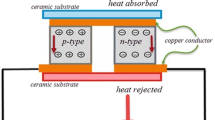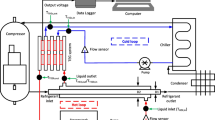Abstract
Thermoelectric refrigeration has the outstanding advantage of allowing accurate temperature control. However, on the market there are thermoelectric refrigerators which include on/off temperature control systems, because of their simplicity and low cost. The major problem with this system is that, when the thermoelectric modules are switched off, the heat stored in the heat exchanger at the hot end of the modules goes back into the refrigerator, forming a thermal bridge. In this work, we use a computational model, presented and validated in previous papers, to study alternative control systems. A new system is introduced based on idling voltages; that is, once the temperature of the refrigerator reaches the lower limit, the thermoelectric modules are not switched off but supplied with minimum voltage. Computational results prove that this system reduces the electric power consumption of the refrigerator by at least 40% with respect to that obtained with on/off control systems, and the coefficient of performance increases close to the maximum provided by any other control system.
Similar content being viewed by others
Abbreviations
- C :
-
Thermal capacity (J/K)
- COP:
-
Coefficient of performance
- c p :
-
Specific heat at constant pressure (J/kg K)
- D :
-
Difference between limits of the inner temperature (°C)
- E :
-
Environment temperature (°C)
- E s :
-
Thermoelectric force due to Seebeck effect (V)
- EPC:
-
Electric power consumption (W)
- e :
-
Wall thickness (m)
- h ext :
-
External convective heat transfer coefficient (W/m2 K)
- h int :
-
Internal convective heat transfer coefficient (W/m2 K)
- I :
-
Electric current (A)
- k :
-
Thermal conductivity (W/m K)
- L :
-
Lower limit of the inner temperature (°C)
- Nu:
-
Nusselt number
- Pr:
-
Prandtl number
- \( \dot{Q} \) :
-
Heat flow rate (W)
- \( \dot{Q}_{\rm{C}} \) :
-
Heat flow rate absorbed by the thermoelectric modules (W)
- \( \dot{Q}_{\rm{P}} \) :
-
Heat flow rate due to Peltier effect (W)
- \( \dot{Q}_{\rm{J}} \) :
-
Heat flow rate due to Joule effect (W)
- \( \dot{q} \) :
-
Specific heat flow rate (W/m3)
- \( \dot{Q}_{0} \) :
-
Heat flow rate going back into the compartment (W)
- R :
-
Thermal resistance (K/W)
- R elect :
-
Electric resistance (Ω)
- Re:
-
Reynolds number
- S :
-
Surface area (m2)
- T :
-
Temperature at instant of time τ (K)
- T′:
-
Temperature at instant of time τ + δτ (K)
- U :
-
Heat transfer coefficient (W/m2 K)
- V :
-
Voltage supplied to the thermoelectric modules (V)
- X :
-
Length (m)
- v :
-
Volume (m3)
- α :
-
Seebeck coefficient (V/K)
- τ :
-
Time (s)
- δ :
-
Density (kg/m3)
- π :
-
Peltier coefficient (V)
References
J.G. Vián, D. Astrain, and M. Dominguez, Appl. Therm. Eng. 22, 407 (2002).
S.B. Riffat and M. Xiaoli, Appl. Therm. Eng. 23, 913 (2003).
G. Min and D.M. Rowe, Appl. Energy 83, 133 (2006).
J.G. Vián and D. Astrain, Appl. Therm. Eng. 29, 1935 (2009).
D.M. Rowe, Thermoelectrics Handbook Macro to Nano, 1st ed. (Boca Raton, FL: CRC, 2006).
L.E. Bell, Science 321, 1457 (2008).
http://www.waeco.com/en/products/3111.php Accessed December 2011.
S. Shaojing and Q. Qin, 1st International Conference on Electrical and Control Engineering (China, Wuhan, 2010), p. 2245.
S. Song and J. Wang, Appl. Mech. Mater. 130–134, 1919 (2012).
http://www.omega.com/guides/temperaturecontrollers.html Accessed December 2011
D. Astrain, J.G. Vián, and J. Albizua, Appl. Therm. Eng. 25, 3149 (2005).
M.N. Ozisik, Finite Difference Methods in Heat Transfer, 1st ed. (Boca Raton, FL: CRC, 1994).
G.V. Parmelee and R.G. Huebscher, Heat Piping Air. Cond. 19, 115 (1947).
T.M. Ritzer and P.G. Lau, 13th International Conference on Thermoelectrics (Kansas City, Missouri, USA, 1994), p. 177.
D.C. Montgomery, Design and Analysis of Experiments, 6th ed. (Hoboken, NJ: Wiley, 2005).
W.M. Rohsenow, J.P. Hartnett, and Y.I. Cho, Handbook of Heat Transfer, 3rd ed. (New York: McGraw-Hill, 1998).
M.J. Moran and H.N. Shapiro, Fundamentals of Engineering Thermodynamics, 5th ed. (Hoboken, NJ: Wiley, 2006).
Author information
Authors and Affiliations
Corresponding author
Rights and permissions
About this article
Cite this article
Astrain, D., Martínez, A., Gorraiz, J. et al. Computational Study on Temperature Control Systems for Thermoelectric Refrigerators. J. Electron. Mater. 41, 1081–1090 (2012). https://doi.org/10.1007/s11664-012-2002-0
Received:
Accepted:
Published:
Issue Date:
DOI: https://doi.org/10.1007/s11664-012-2002-0




